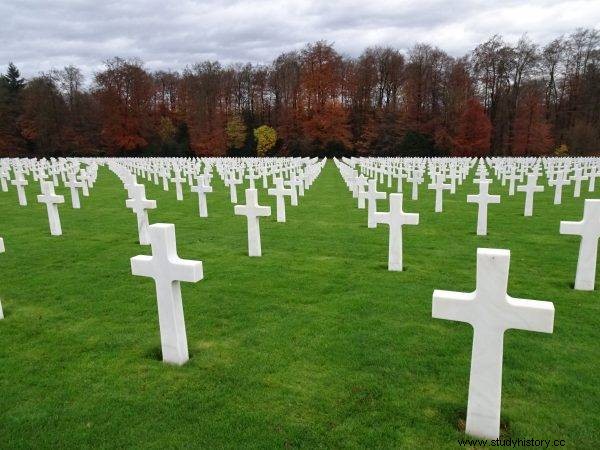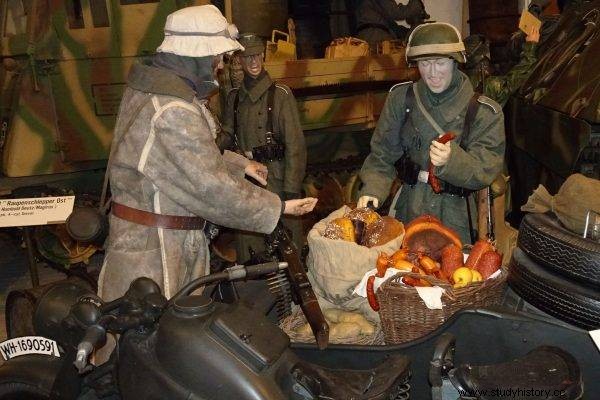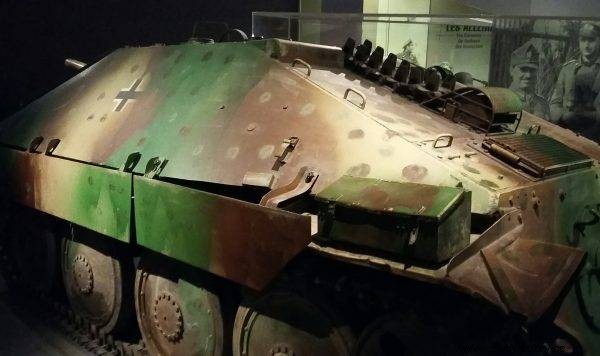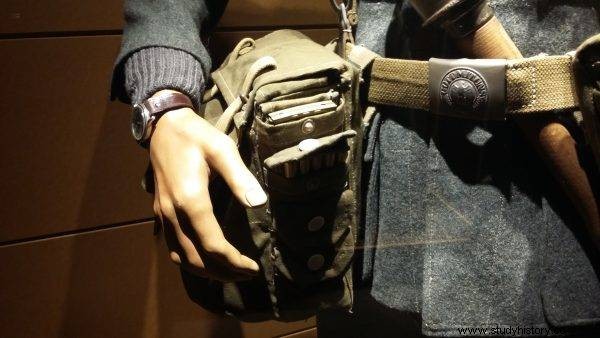We have something special for you on the anniversary of the Battle of the Ardennes. We have prepared an expert ranking of the most interesting museums commemorating this great battle. If you ever hit the Ardennes, you won't be wandering in the dark - like Colonel von der Heydte's paratroopers thrown in a snow blizzard.
The Battle of the Ardennes, called the Battle of the Bulge by the Americans, and the "Wacht am Rhein" by the Germans, was one of the greatest clashes of World War II on the Western Front. The Germans mobilized about 500,000 soldiers and over 1,500 armored vehicles, although the Third Reich was already at the end of its strength.
The counteroffensive at the turn of 1944 and 1945 on the German-Belgian-Luxembourg border lasted over a month! We wrote about the battle itself HERE . In this article, we present something completely different. The envoy of "Historical Curiosities" visited the most interesting museums in the Ardennes especially for you and - after consultation with history buffs - created the "TOP 5" ranking.
Last chance offensive
The Ardennes mountain range itself is not a great tourist attraction. These are hilly, sparsely populated areas with the highest hill, Signal de Botrange (694 m above sea level). The remaining parts of the range are only 300–500 meters. Today, driving through them by car or bicycle is not a problem - as long as we do it in the summer. In a snowy winter, things are not so simple.
In the fall of 1944, Adolf Hitler, preparing a last-ditch offensive in the West, chose this section of the front to send his elite armored divisions and the best infantry units into battle . They launched the attack on December 16, and their task was to separate British and American troops and capture Antwerp with its precious port.

American soldiers cemetery in Luxembourg
In general, the Germans wanted to cause as much confusion as possible in the rear of the front and cause a conflict between the Western allies. Most of the assumptions they failed to implement. The offensive was quickly stopped, although it cost the Allies a lot of blood - and a lot of shame because the Americans surrounded by whole battalions were taking themselves into captivity. Due to the crisis in the Ardennes, Churchill and Roosevelt even had to ask Stalin to accelerate their operations on the Vistula.
Several cities and towns in the Ardennes have a great symbolic significance (especially for Americans) due to the dramatic events that took place there. Bastogne, where the famous 101st Airborne Division ("Screaming Eagles") did great deeds which defended the city surrounded by Germans and kept it. Other important places, such as:Sankt Vith, Noville, Poteau, Stavelot or - the site of the German war crime - Malmedy, should be known by everyone who is interested in WWII.
In the Ardennes, both in Belgium and Luxembourg, you will find dozens of great museums, hundreds of monuments and many historical memorabilia from the period of the famous battle. In many cities and towns, at the crossroads there are tanks, armored cannons, cannons and monuments, and on the tollgates there are numerous road signs with the inscription "war cementary". Some locals keep large collections of battlefield finds in their barns and garages - including vehicles, weapons, and equipment.
For these reasons, the Ardennes are a popular destination for history enthusiasts who practice military tourism. With the participation of participants in the "Expeditions in the footsteps of World War I and II", the following list of the most interesting museums in the Ardennes was created.
1. Bastogne Barracks
Unanimously recognized as the best on our "hit list". It is a museum, more precisely a center for the interpretation of historical heritage. It was opened relatively recently, in 2010. Located in the old artillery barracks in Bastogne, Belgium.
The place is truly historic, because from these barracks General Anthony McAuliffe commanded the defense of Bastogne in December 1944. In one of the buildings there are meticulously recreated soldiers and officers' quarters, which look exactly like during the war. The scenes that took place here were recreated in the chambers with the help of mannequins. The smallest details were taken care of - for example, on General McAuliffe's bed there are ... peanuts that he liked to chew on and which played a significant role in this bloody battle. 
The heavy equipment hangar makes the biggest impression on visitors. In an incredibly long barrack there are several dozen (maybe even a hundred?) Tanks, tankettes, armored cannons, trucks, passenger cars, cannons, mortars, rocket launchers, technical security vehicles, individual weapons and military "freaks".
Many of the vehicles shown there were used in the Battle of the Ardennes. The museum's collection includes, among others perfectly preserved German PzKpfw IV Ausf J, German armored guns Jagdpanzer 38 (t) and StuG III Ausf F / 8, English tanks Matilda MKII, A34 Comet, Valentine MK IX and Sherman (including Vc "Firefly" and HVSS), American:M22 Locust, M47 Patton, M24 Chaffee, French (Renault UE Chenillette), Soviet T-34 and IS-3, as well as armored cars, incl. Humber LRO MK III, T17E1 Staghound, minesweepers, communications gear, and tons of other metal.
The whole picture is completed with technical barracks, in which we will see tanks and heavy vehicles imported from all over the world, which are renovated and restored to a driving condition in Bastogne Barracks. 
It should be noted that Bastogne Barracks are still a military facility and getting into them is not a simple matter. Advance booking is required; usually there are only two sightseeing tours per day. The guides are active or retired military personnel who know their stuff and provide tours in several languages:incl. in English, French or German (unfortunately they don't speak Polish yet). Tickets are not expensive:EUR 10 for individual visitors, EUR 6 for groups (over 6 people). An additional attraction is the open military canteen, where you can eat up to your ears for little money.
Find out more at:www.bastogne-barracks.be
2. National Museum of Military History in Diekirch
This museum in Luxembourg is not very impressive from the outside. It is located in the old brewery buildings and is located in the city center, between the houses. Despite the tight space in the yard, the M47 Patton, M4 Sherman A1E8 and the powerful American 155mm M1 and M2 "Long Tom" guns could be accommodated. These exhibits are already announcing that it will be interesting inside ...
The museum is "inundated" with weapons and military equipment, which is displayed in every available place:on the floor, on the walls, on the stairs, under the stairs and in various corners of the building. It is worth looking up, because various wonders are hung on ceiling. Military enthusiasts will probably spend many hours there, admiring each exhibit in turn - and there are thousands of them. 
Among the curiosities are, among others German and American encryption machines, knives, bayonets and brass knuckles for hand-to-hand combat, and - found on the battlefield in the Ardennes - a missile from the German secret weapon V3! The Museum in Diekrich also shows large-format dioramas, that is, "frozen in the frame" scenes recreated using authentic-looking mannequins.
Among the dioramas presented in Diekrich, the most impressive is the one in the basement, showing Americans struggling through a snow-strewn forest. Some soldiers are wounded, others have frostbite, there are traces of blood in the snow. The diorama is so realistic that even in the hottest summer here you can feel biting frost and ... fear.
Audio guides in six languages are available, and the museum can also be visited with a guide, but this is not necessary as the exhibition is so suggestive that no additional words or descriptions are needed. You must reserve at least 2-3 hours for the tour. Tickets cost 5 euros, group tickets (from 10 people) - 3 euros. Interestingly, you can enter the museum with your dog!
See more at:www.mnhm.net
3. 101st Airborne Museum
Another great military museum, in comparison to which, unfortunately, Polish ones are quite pale. This is dedicated to the soldiers of the 101st Airborne Division that defended Bastogne during the German offensive in the Ardennes. The museum is located in the building of the former officers' mess and has several floors. The exhibits were donated by private collectors who created the facility in 2009.
Airborne army enthusiasts will feel like in paradise here, because dozens of parachutes hang from the walls and ceilings, and the number of original exhibits is breathtaking. In one of the nooks and crannies on the stairs I found, for example, an exhibition devoted to the Indians fighting in the ranks of the 101st DPD - so there is an "Indian" combat knife with a decorated scabbard, a tobacco bag and tribal symbols.

December'44 Museum battle scene in the building
The exhibits are precisely described, we will find out who the gun, jump boots or helmet belonged to. The dioramas are very realistic, often too much, bullet holes are visible in the window panes, there are smoke spots in the rooms, shot plaster, blood stains, damaged home equipment ...
The "Bombing Experience", which can be experienced on the lowest floor, makes the biggest impression on visitors. Visitors move to the basement of the Bastogne Siege and experience an aerial bombardment. They perceive information with all their senses:lights blink and go out, dust flies from the ceiling, you hear aircraft engines, bomb whistles and explosions. I will not reveal more details, but I would like to add that many tourists leave the cellar pale. They already know all about the siege of Bastogne. (However, we do not recommend this "attraction" to children). 
Tickets to the parachute museum cost 10 euros, groups (from 10 people) pay 9 euros. There is also a cinema in the museum which is worth checking out if you are spending a little more time in Bastogne. In the museum, you can sometimes meet veterans of the 101st DPD, although unfortunately there are less and less of them, as most of them are already finishing hundreds. While in Bastogne, don't forget to check out the M4A3 Sherman Barracuda, standing in the main square of the city.
More at:www.101airbornemuseumbastogne.com
4. Bastogne War Museum
The modern Bastogne War Museum has a completely different character. He is primarily attracted to his surroundings. Next to it there is the famous Mardasson Memorial - a monument commemorating the Americans who fought and died in the Ardennes. At the parking lot, there is also a world-recognizable monument with a romantic scene depicting a sailor kissing a girl. It's not so romantic inside anymore.
The museum has a narrative form and historical exhibits do not play such a big role here. The multimedia story is more important. At the entrance, we choose the person we will play as when visiting the exhibition . It can be a soldier (American or German), a woman or a child. Depending on our choice, the audio guide will guide us through the exhibition, commenting on it from the individual perspective of a soldier, 13-year-old or woman who found herself in the middle of hostilities in the Ardennes.
As I mentioned, there are not many exhibits, but they are very interesting. Among them there are copies of the so-called trench art, i.e. personal items made of war remains - scales, bayonets, helmets.

Hetzer of the Bastogne War Museum
There are many engaging elements at the exhibition that encourage interaction. This and that can be twisted, moved, touched. An important part of the tour is the screening of the film in a cinema stylized as a winter forest. A large part of the exhibition is devoted to the fallen, both soldiers and civilians. The museum will appeal to tourists who prefer to listen to stories rather than to view items in showcases. After the tour, you can visit a well-stocked shop (it's the best historical bookstore in the Ardennes) or a restaurant.
It is worth paying attention to the interesting architectural shape of the museum and its surroundings. From the hill you have a wonderful view of the rolling countryside of the Ardennes with the city of Bastogne in the foreground. The tour will take at least two hours, but it's worth booking even three or four. Tickets are quite expensive (16 Euro) but worth the price.
See:www.bastognewarmuseum.be
5. December 44 - Historical Museum
It is a small but very modern museum in Le Gleize, Belgium, visited by armor lovers from all over the world. The main reason is the German Tiger II tank, the so-called Royal Tiger, side number 213. The tank is perfectly preserved, its armor shows traces of bullets. The history of this monster is well researched and documented. It is known that a certain resident of Le Gleize bought it from the Americans ... for a bottle of cognac.
However, it would be a mistake to leave Le Gleize just looking at the tank, because right behind it is a great museum with wonderful exhibits from the period of the fighting in the Ardennes. The figures of the soldiers in the showcases are perfectly prepared, and the weapons and equipment on display are perfectly preserved. Everyday items found in the battlefields in the area make a great impression:toothbrushes, shot cigarette cases, crushed canteens, broken bayonets, perforated helmets. There are over 5,000 exhibits, and the museum is only 1,000 square meters. 
Entry to the museum in Le Gleize costs EUR 7.50, for groups (over 15 people) - EUR 6. After sightseeing, it is worth visiting the museum shop, where you will find, among others a lot of original artifacts from the Second World War. You can buy a soldier's shovel or an original SS helmet for a reasonable price (for a slightly higher price, around 500 euros).
More at:www.december44.com
The best time to come to the Ardennes is mid-December. Historical events, shows and parades take place in many cities over the weekend, around 16–20 December. The largest of these is held in Bastogne and is called "Nuts".
You have to keep your eyes on the spot, because at many intersections there are armored vehicles and cannons - not only American, but also British and German. A battered Panther Ausf lurks in Celles. G (2nd Panzer-Division), the intersection at the Wibrin church is guarded by the M4 Sherman, torn apart by an explosion and damaged by missiles, and before entering La Roche we will see the M10c Achilles MkII with its own name Northamton. In short - there is a lot to admire!
